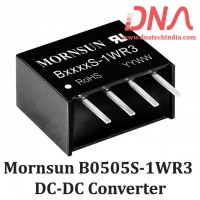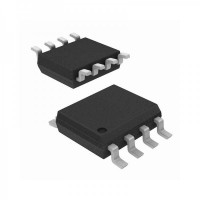Introduction to Capacitors |
|
Just like the Resistor, the Capacitor, sometimes referred to as a Condenser, is a passive device, and one which stores its energy in the form of an electrostatic field producing a potential difference (Static Voltage) across its plates. In its basic form a capacitor consists of two or more parallel conductive (metal) plates that do not touch or are connected but are electrically separated either by air or by some form of insulating material such as paper, mica or ceramic called the Dielectric. The conductive plates of a capacitor can be either square, circular or rectangular, or be of a cylindrical or spherical shape with the shape and construction of a parallel plate capacitor depending on its application and voltage rating. |
|
When used in a direct-current or DC circuit, a capacitor blocks the flow of current through it, but when it is connected to an alternating-current or AC circuit, the current appears to pass straight through it with little or no resistance. If a DC voltage is applied to the capacitors conductive plates, a current flows charging up the plates with electrons giving one plate a positive charge and the other plate an equal and opposite negative charge. This flow of electrons to the plates is known as the Charging Current and continues to flow until the voltage across both plates (and hence the capacitor) is equal to the applied voltage Vc. At thispoint the capacitor is said to be fully charged with electrons with the strength of this charging current at its maximum when the plates are fully discharged and slowly reduces in value to zero as the plates charge up to a potential difference equal to the applied supply voltage and this is illustrated below. |
|
|
Capacitor Construction |
|
|
|
The parallel plate capacitor is the simplest form of capacitor and its capacitance value is fixed by the surface area of the conductive plates and the distance or separation between them. Altering any two of these values alters the the value of its capacitance and this forms the basis of operation of the variable capacitors. Also, because capacitors store the energy of the electrons in the form of an electrical charge on the plates the larger the plates and/or smaller their separation the greater will be the charge that the capacitor holds for any given voltage across its plates. In other words, larger plates, smaller distance, more capacitance. |
|
By applying a voltage to a capacitor and measuring the charge on the plates, the ratio of the charge Q to the voltage V will give the capacitance value of the capacitor and is therefore given as: C = Q/V this equation can also be re-arranged to give the more familiar formula for the quantity of charge on the plates as: Q = C x V |
|
Although we have said that the charge is stored on the plates of a capacitor, it is more correct to say that the energy within the charge is stored in an "electrostatic field" between the two plates. When an electric current flows into the capacitor, charging it up, the electrostatic field becomes more stronger as it stores more energy. Likewise, as the current flows out of the capacitor, discharging it, the potential difference between the two plates decreases and the electrostatic field decreases as the energy moves out of the plates. |
|
The property of a capacitor to store charge on its plates in the form of an electrostatic field is called the Capacitance of the capacitor. Not only that, but capacitance is also the property of a capacitor which resists the change of voltage across it. |
|
|
The Capacitance of a Capacitor |
|
The unit of capacitance is the Farad (abbreviated to F) named after the British physicist Michael Faraday and is defined as a capacitor has the capacitance of One Farad when a charge of One Coulomb is stored on the plates by a voltage of One volt. Capacitance, C is always positive and has no negative units. However, the Farad is a very large unit of measurement to use on its own so sub-multiples of the Farad are generally used such as micro-farads, nano-farads and pico-farads, for example. |
|
|
Units of Capacitance |
|
Microfarad (μF) 1μF = 1/1,000,000 = 0.000001 = 10-6 F |
|
Nanofarad (nF) 1nF = 1/1,000,000,000 = 0.000000001 = 10-9 F |
|
Picofarad (pF) 1pF = 1/1,000,000,000,000 = 0.000000000001 = 10-12 |
|
The capacitance of a parallel plate capacitor is proportional to the area, A of the plates and inversely proportional to their distance or separation, d (i.e. the dielectric thickness) giving us a value for capacitance of C = k( A/d ) where in a vacuum the value of the constant k is 8.84 x 10-12 F/m or 1/4.π.9 x 109, which is the permittivity of free space. Generally, the conductive plates of a capacitor are separated by air or some kind of insulating material or gel rather than the vacuum of free space. |
|
|
|
|
The Dielectric of a Capacitor |
|
As well as the overall size of the conductive plates and their distance or spacing apart from each other, another factor which affects the overall capacitance of the device is the type of dielectric material being used. In other words the "Permittivity" (ε) of the dielectric. The conductive plates are generally made of a metal foil or a metal film but the dielectric material is an insulator. The various insulating materials used as the dielectric in a capacitor differ in their ability to block or pass an electrical charge. This dielectric material can be made from a number of insulating materials or combinations of these materials with the most common types used being: air, paper, polyester, polypropylene, Mylar, ceramic, glass, oil, or a variety of other materials. |
|
The factor by which the dielectric material, or insulator, increases the capacitance of the capacitor compared to air is known as the Dielectric Constant, k and a dielectric material with a high dielectric constant is a better insulator than a dielectric material with a lower dielectric constant. Dielectric constant is a dimensionless quantity since it is relative to free space. The actual permittivity or "complex permittivity" of the dielectric material between the plates is then the product of the permittivity of free space (εo) and the relative permittivity (εr) of the material being used as the dielectric and is given as: |
|
|
Complex Permittivity |
|
ε = εo x εr |
|
As the permittivity of free space, εo is equal to one, the value of the complex permittivity will always be equal to the relative permittivity. Typical units of dielectric permittivity, ε or dielectric constant for common materials are: Pure Vacuum = 1.0000, Air = 1.0005, Paper = 2.5 to 3.5, Glass = 3 to 10, Mica = 5 to 7, Wood = 3 to 8 and Metal Oxide Powders = 6 to 20 etc. |
|
This then gives us a final equation for the capacitance of a capacitor as: |
|
Capacitance, C = (εo x εr x A)/d Farads |
| One method used to increase the overall capacitance of a capacitor is to "interleave" more plates together within a single capacitor body. Instead of just one set of parallel plates, a capacitor can have many individual plates connected together thereby increasing the area, A of the plate. For example, a capacitor with 10 interleaved plates would produce 9 (10 - 1) mini capacitors with an overall capacitance nine times that of a single parallel plate. |
 |
|
Modern capacitors can be classified according to the characteristics and properties of their insulating dielectric: |
|
Low Loss, High Stability such as Mica, Low-K Ceramic, Polystyrene. |
|
Medium Loss, Medium Stability such as Paper, Plastic Film, High-K Ceramic. |
|
Polarized Capacitors such as Electrolytic's, Tantalum's. |
|
|
Voltage Rating of a Capacitor |
|
All capacitors have a maximum voltage rating and when selecting a capacitor consideration must be given to the amount of voltage to be applied across the capacitor. The maximum amount of voltage that can be applied to the capacitor without damage to its dielectric material is generally given in the data sheets as: WV, (working voltage) or as WV DC, (DC working voltage). If the voltage applied across the capacitor becomes too great, the dielectric will break down (known as electrical breakdown) and arcing will occur between the capacitor plates resulting in a short-circuit. The working voltage of the capacitor depends on the type of dielectric material being used and its thickness. |
|
The DC working voltage of a capacitor is just that, the maximum DC voltage and NOT the maximum AC voltage as a capacitor with a DC voltage rating of 100 volts DC cannot be safely subjected to an alternating voltage of 100 volts. Since an alternating voltage has an r.m.s. value of 100 volts but a peak value of over 141 volts!. Then a capacitor which is required to operate at 100 volts AC should have a working voltage of at least 200 volts. In practice, a capacitor should be selected so that its working voltage either DC or AC should be at least 50 percent greater than the highest effective voltage to be applied to it. |
|
Another factor which affects the operation of a capacitor is Dielectric Leakage. Dielectric leakage occurs in a capacitor as the result of an unwanted leakage current which flows through the dielectric material. Generally, it is assumed that the resistance of the dielectric is extremely high and a good insulator blocking the flow of DC current through the capacitor (as in a perfect capacitor) from one plate to the other. However, if the dielectric material becomes damaged due excessive voltage or over temperature, the leakage current through the dielectric will become extremely high resulting in a rapid loss of charge on the plates and an overheating of the capacitor eventually resulting in premature failure of the capacitor. Then never use a capacitor in a circuit with higher voltages than the capacitor is rated for otherwise it may become hot and explode. |
|
|
Introduction to Capacitors Summary |
|
The job of a capacitor is to store charge onto its plates. The amount of electrical charge that a capacitor can store on its plates is known as its Capacitance value and depends upon three main factors. |
|
The surface area, A of the two conductive plates which make up the capacitor, the larger the area the greater the capacitance. |
|
The distance, d between the two plates, the smaller the distance the greater the capacitance. |
|
The type of material which separates the two plates called the "dielectric", the higher the permittivity of the dielectric the greater the capacitance. |
|
|
|
The dielectric of a capacitor is a non-conducting insulating material, such as waxed paper, glass, mica different plastics etc, and provides the following advantages. |
|
The dielectric constant is the property of the dielectric material and varies from one material to another increasing the capacitance by a factor of k. |
|
The dielectric provides mechanical support between the two plates allowing the plates to be closer together without touching. |
|
Permittivity of the dielectric increases the capacitance. |
|
The dielectric increases the maximum operating voltage compared to air. |
|
All capacitors have a maximum working voltage rating, its WV DC so select a capacitor with a rating at least 50% more than the supply voltage. |
|
|
|
There are a large variety of capacitor styles and types, each one having its own particular advantage, disadvantage and characteristics. To include all types would make this tutorial section very large so in the next tutorial about The Introduction to Capacitors I shall limit them to the most commonly used types. |
|
|
| Reproduced with permission from Wayne Storr |
| ( http://www.electronics-tutorials.ws/capacitor/cap_1.html ) |





